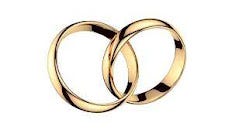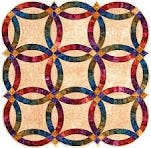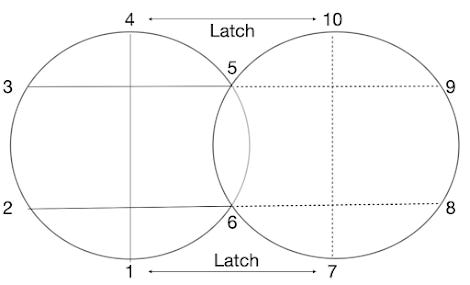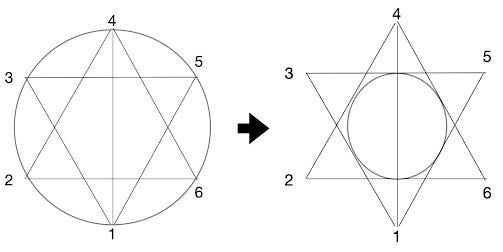The Double Wedding Band Model: a Possible New Model for a 10-Part Strike and Ellacott Series

As many of you know, I am fond of applying structural models to both Harry Potter and Cormoran Strike novels. I owe a debt of gratitude to John Granger for his inspirational work on Ring Composition and Parallel Series. John is doing some very interesting work on ring structure within the nine parts of The Running Grave, which, if you are interested in the book's internal structure, is worth checking out on his regular and Substack sites, along with the excellent work by his current colleagues Nick Jeffrey, Evan Willis and Elizabeth Baird Hardy.
Ever since JKR/RG confirmed that the Strike series would be ten books, I've been going over how Ring Structure and Parallel Series models can be adjusted into a a model that fits, especially since so many of the predictions made originally, like The Running Grave linking to Cuckoo's Calling and Lethal White and having lots of Deathly Hallows echoes., seem to still be coming true. I've also been scratching my head for something that accounts for the relatively simple observations that even and odd-numbered books seem to pair up with each other well, as well as the special connections and resets between Troubled Blood and The Ink Black Heart.
And, I think I have something that works, at least until Book Eight comes out. More information, and TRG spoilers, after the jump.

I'm starting with the model that worked so well for the Harry Potter series, the 7-part ring. For those unfamiliar with it, I will share an adapted diagram from a joint Queen City Mischief and Magic presentation John Granger and I did back in 2020.

The "turtleback" structure places the seven books in a circle, with the repeated elements of 1. Philosopher's Stone and 7. Deathly Hallows forming a latch, and both connecting vertically to the story-turn book in the center, 4. Goblet of Fire. The horizontal lines connect 2. Chamber of Secrets and 6. Half-blood Prince, with their book-within-the-book theme and 3. Prisoner of Azkaban and 5. Order of the Phoenix, the two Sirius Black-focused books.

At the time of the talk, 5. Troubled Blood had just been published and we assumed a similar pattern would follow, looking something like this. However, when seven books became ten, this model would clearly no longer work. My initial solution, the Double Pentagram, was not as satisfactory after the publication of 6. The Ink Black Heart and 7. The Running Grave, because it did not account for the connections of those two books to the first five.
In thinking about a new model, I considered not only the need to accommodate ten books, but the fact that Books 5 and 6 were linking to all three of the last Harry Potter texts, and that Book Five was structured on the same alchemical year-long cycle as Deathly Hallows, and could have actually provided a nice ending to Robin's story. That, coupled with the fact that 7. The Running Grave made the expected latch with 1. Cuckoo's Calling and story-turn link to 4. Lethal White, and I was convinced the seven-part ring had to be part of this. And we know any ring demands symmetry
My solution? Instead of two pentagrams, what about two seven-part rings? But, to give us ten books instead of fourteen, the rings have to be linked not just by the beginning and ending latches, but by the two central books. This gives us overlapping rings. The easiest way to represnt this visually is with two circles. Thie first ring starts with Book 1 on the bottom, moves clockwise past 2 and 3 to 4 at the top, then down past 5 and 6 and latches with seven. The second ring starts with 4 at the top, moves counterclockwise down to 7 at the bottom to latch with 10 at the top.


Thus, the series begins with the first book of a 7-part ring, and ends with the 7th book of a 7 part ring. They're just different rings. Because this model looks like the pattern on a Double Wedding Band quilt, and because lots of us are predicting a wedding for Strike and Robin in the series finale, I am going to tentatively call this the Double Wedding Band model.
One cool aspect of this: Book 5 is where Robin's cousin Katie tells her Robin was "moving in the opposite direction from the rest of us." Under this model, Book 5 is the first stop after the counterclockwise ring begins.
If you draw in the expected "turtleback lines, you get something that looks like this. (solid lines = observed, dashed = predicted).

And, if you add in the observed (1-4-7) and predicted (4-7-10) latch-story turn links, then you'd get a diagram like this. I am also assuming there will be a final closing latch between the first (1) and last (10) books of the series, (red = observed, blue = predicted.)

Put together the turtle back lines and the story-turn/latch lines and it looks like this:

However, , this isn't all the connections we see. As has been observed before, the connections seem to "leapfrog" between books, with even books connecting to even and odd to odd. Some of those even-even and odd-odd lines are accounted for in the horizontal turtleback lines, but I have added the diagonal lines here, again with observed in red, and predicted in blue, The story-turn/latch lines have been removed for clarity.

As you can see, 6-point "stars of David" appear inside the circles. Add the vertical story-turn/latch lines back and you have this.

What I like about this is, that if you move the circle from outside the triangles to inside the hexagon, you get what looks like two Deathly Hallows symbols, overlaid on each other.

This probably means absolutely nothing, but it is cool, aesthetically. One of the reasons I liked my original Pentagram model is because it matched the pentagrams Bill Talbot drew all over his notebook. But I digress.
However, this is still not all the connections you see. As I showed a little over a year ago, 5. Troubled Blood, had the expected links to 3. Career of Evil, but also had lots of connections to 2. The Silkworm. You can see a long list here, but for starters:
a mystery with a dark, disturbing book at its core.
connections to real-life severe weather.
the first indicator that Robin likes personalized gifts way more than flowers.
At the time, I even speculated that TB had originally been planned as the sixth book of the series. I also speculated that 6. The Ink Black Heart would have both the predicted turtle-back connections to 2. The Silkworm, but also complementary connections to 3. Career of Evil. That prediction also came true. The most obvious connection?
An annoying character who uses a wheelchair but can walk.
That character runs an online support group for patients who share the condition and complain loudly about unhelpful or unsympathetic health care providers.
Robin persuades a frightened teenage user of the site to speak with her.
So, I am adding red 2-5 and 3-6 diagonals to the first ring, and predicting the same ones for the second ring.
I also added another vertical line between 5 and 6, given the connections seen between those two. Those books have a special position as the two points of overlap on the rings.

Once we see the model, the oddness around Books Five and Six starts to make a bit more sense. Troubled Blood is #5 on the first ring, but #2 on the second. #5 is a position we would predict for a dark, nigredo-type story, where the protagonist is broken down. But, #2 in the Strike series, The Silkworm, was a wet, snowny reverse-albedo, at least for Robin. Hence, Strike's nigredo came in a wet form, not a hot and dry one as might be expected, and was mixed in with a lot of traditionally albedo images like the name Margot (pearl), queen Cynthia Phipps, the moons on the tarot cards, etc. 6. The Ink Black Heart was much more "pure" nigredo: Strike's physical breakdown, the name Darcy (dark) and the fiery destruction of the office. However, there was a dry albedo element I predicted: the bleached white coral decor in at the Marine Hotel. It is interesting that in TRG, when Robin recalled that trip, that is what she rememberd: "The white coral on the mantelpieces, set against slate-coloured walls, and the sight of Strike laughing opposite her."
This model also predicts that TRG, like LW will provide a major turn in the story. For Robin, her major turn came when she left Matthew; for Strike, that turn came with Charlotte's death.
So, putting the entire model together gives a pretty complex drawing, but then again, JKR/RG is writing a pretty complex series.

What should be fun, as we re-read TRG, is to see what my be expected in Books 8 and beyond, based on this model. But I'm going to give myself soe time to process, and re-process, the latest book first.



